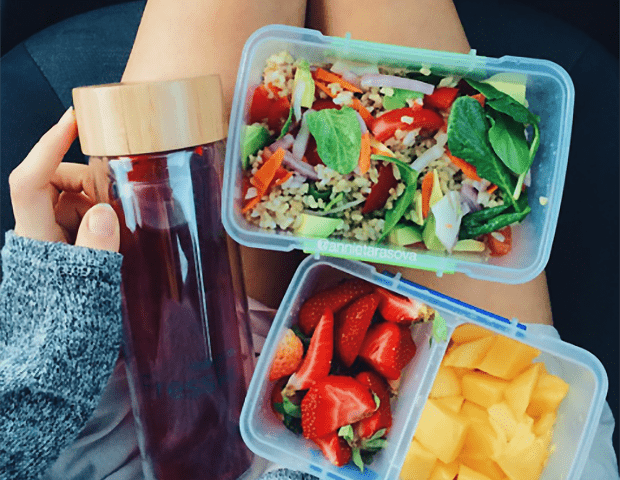
Sample from…
Chapter One: So Little Time to Eat Right
Ever feel you don’t have enough time to cook properly? Find yourself reaching for the quick, convenient packaged food options when shopping, even though you know this isn’t the food you want your family or yourself eating?
There are many reasons to be short of time. Work. Family. Sport. Just a busy lifestyle! Cooking a proper meal can often seem daunting following a long workday. Picture this: you get home, it’s late, it’s dark, and the frozen pizza beckons. You pull down one of your trusty cook books and the recipe has a quizillian ingredients, all of which need to be washed, chopped, processed, blended, cooked in a precise order. There are hungry kids waiting.
Or you finish work early. Get to the gym, hop on your bike, or into running shoes, chew through some serious kilometres and sweat out some serious calories. You’re truly exhausted and hungry so you definitely need something more than fast-food, but you could do with some well-earned rest too. The whole idea of coming home and then cooking an entire nutritious meal from scratch is exhausting.
The fact is you’re not alone. We’ve built a society which tells us to eat healthy, but provides a raft of quick unhealthy food and takes away our time to cook healthy.
But there is a timesaving solution. There are ways that without too much effort you can claw back some of that valuable time and eat the way you want to.
The key to this is planning.
“Give me six hours to chop down a tree and I will spend the first four sharpening the axe.”
― Abraham Lincoln
Having a plan of action and spending time on the groundwork enables you to meet your goals. Here your goal is to eat healthy, cook nutritious (and don’t forget tasty) meals every day of the week while fitting this into your normal, busy routine.
So, let’s have a look at sharpening that axe and figure out why it’s so important.
Chapter Two: Meal Prep, and How it Can Help You.
So you’re having a night out in London with some friends, a meal at Restaurant Gordon Ramsay (or any other restaurant owned by celebrity chef or any other) — you place an order, enjoy some drinks, then the food appears as if by magic, some entrees first, then piping hot mains. It’s a Saturday night and the restaurant’s busy. It will be full of people much of the evening. Satisfied customers coming and going. Everyone seems to get their meals in a timely manner, and they are of a high standard. You might marvel at how they do it.
Well the secret to how restaurants get meals cooked and served to customers without it taking hours is simple: food preparation.
Staff come in early, perhaps at 8am if there’s a lunch service. What do they do while there are no customers around? They prep. They wash and chop vegetables, slice and marinate meats, prepare sauces, arrange salad ingredients. The prepped food is carefully put into separate containers and stacked away in the refrigerator until they’re needed. You can be sure that when you place your order the chefs out back aren’t staring to peel potatoes to make your meal 100% from scratch.
Just how extensive this preparation is can depend on the food being served and the specifics of the restaurant but it can be very extensive. Cut vegetables may be sautéed ahead of time, then reheated in a hot pan with some olive oil and chicken stock. Rice and pasta may be undercooked first, then finished off when you place your order. Braised meats are made in huge batches ahead of time. Roast chickens are roasted, stored, and then re-cooked in the oven with butter and chicken stock. Only meats or fish that might be served medium or rare will have no precooking — steaks or salmon for example. Mashed potatoes: cooked and mashed, then reheated with milk. Poached eggs could be 90% cooked, chilled quickly, and then poached the last 10% for service. Almost all desserts are pre-made. Very few menu items would be, or in fact need to be, made to order.
What this achieves is it takes (most) of the stress out of cooking and saves valuable time.
For a busy restaurant it would be logistically impossible to cook even a dozen different menu items from scratch, get them all out on time without having disgruntled customers. But it’s the time saving aspect you can take and apply to your own meals.
With the basics of meal prep you can learn the lessons of professional chefs and provide a nutritious, quick meal for a large family in record time.
Just how much prep you do is up to you. You’ll find professional kitchens will vary this depending on their specific needs, and likewise you need to find what suits your needs and the kinds of foods you cook. Meal prep could mean you cut the meat and vegetables you need for the following days meal and store them, ready to go, or you can go so far as having cooked, ready to eat meals stored in compartmental containers in the fridge or freezer for the whole week. How much meal prep you do depends on your own specific lifestyle.
You might, for example, be fine with cooking from scratch on weekends. Even some weekdays might be okay. The thing is you probably know already there are some days of the week it’s just not going to be easy to cook a meal. There are days that your experience shows there will be a time crunch. It could be a regular extra activity like a child’s sports practice that will make time tight, perhaps there’s a night you do a training course, or maybe you just want to get to the gym two or three nights a week. Then again EVERY night might be a constant dilemma of no time versus needing a good quality meal. You know the ins and outs of your life, so here are some ideas you can adapt to your lifestyle to make meal times a little less stressful.
Chapter Three: Meal Prep 101
What do you eat? Or what do you like to eat? This isn’t a recipe book or a diet book, and you won’t have to change what you cook all that much to incorporate meal prep into your busy lifestyle. The only thing to keep in mind as far as what you cook goes is the acronym K.I.S.S or Keep It Simple, Stupid. Coined by the U.S. Navy in the 1960s it conveys the principle that systems work best if they are kept simple rather than made more complicated. In relation to meal prep all this means is it works best if you choose some good, simple, healthy meals, which don’t involve hundreds of ingredients, spices, stages and decoration. Keep it simple!
Let’s look at the essential ingredients of meal prep.
- Select simple recipes which can be easily prepped ahead of time.
We’re all up for a challenge. Boeuf Bourguignon may be the classic French Beef dish, perhaps even the greatest beef concoction known to mankind, but when celebrity chef Julia Child’s recipe fills three pages of her cookbook with a long list of ingredients rivalling Craig’s (list), and references two other side dishes, that you really need to do Boeuf Bourguignon justice, it’s the kind meal that will take you an afternoon to prepare, and probably shouldn’t be included with easy-to-prep recipes that make your life easier.
So what are the best recipes?
Meals that have ingredients and elements that can be prepared in advance. A simple beef casserole for example. It requires advanced work before the cooking can begin. You have meat to cut into general cube shapes (or any shape you prefer really), and onions (which can be diced in advance), also carrots which can be cut and blanched. What do you serve with it? Mashed potato or pasta. Both of which could have some advanced prep magic worked upon them.
A vegetable curry is another good example. It not only has the obvious vegetables you can wash, chop and container, but also sauce that you could make a double portion of and freeze or refrigerate. That could also be next week’s Chicken Curry taken care of.
We’ll give you some excellent examples later in this book, but take a critical glance over your recipe books. You’ll see what can be easily prepped in advance and what can’t. A quiche is another good example. You can do the pastry. There are toppings (mushrooms, leeks, tomatoes or chicken) which can be chopped in advance. Also the dreaded, time-consuming cheese grating.
- Plan your week’s meals in advance.
What shall we have tonight, honey?
How many times have you heard this? How many times has it been you saying it? We might plan our work day, plan our career, plan a trip to a foreign destination, but we find it harder to apply this same planning to something simpler like our eating habits. Perhaps we’ve just had enough planning by then? Planning meals for the week shouldn’t be a headache. In fact it should take the headache out of meal time, and all that indecision. No more need to reply: “Dunno. What’s in the fridge?”
A meal plan simplifies life and is essential for meal prep. To prep in advance you need to know what it is you will eat in advance (at least for the next 3-7 days).
A meal plan for a week could look something like this:
| Monday | Tuesday | Wednesday | Thursday | Friday | Saturday | Sunday | |
| Breakfast | Breakfast Ham and Egg Muffin | Berry Muesli | Scrambled Eggs | Breakfast Date Bread Kebabs | Berry Muesli | Breakfast Ham and Egg Muffin | French Toast |
| Lunch | Protein Bistro Box | Greek Salad | Microwave Frittata | Chicken Caesar salad | Quinoa tabouleh | Protein Bistro Box | Penne with Pesto |
| Dinner | Spicy Chicken with Rice & Crisp Red Onions | Pork Sliders with Avocado | Honey Chicken | Navratan Korma | Garlic Grilled Fish with Couscous | Pea & New Potato Curry | Tuna Casserole |
Let’s look at how we might go about meal prep for one of these days.
BREAKFAST
Breakfast Ham and Egg Muffins
Ingredients
- 6 large eggs
- Salt & pepper, to taste
- 6 English muffins
- 6 slices sharp cheddar cheese
- 6 small slices ham
Meal Prep
A hearty breakfast can really set you up for the day, most of us though barely have time to grab a plate of cornflakes and a coffee. Here’s where meal prep can help. These delicious Breakfast Muffins can be prepared well in advance, and here’s how.
Preheat oven to 350 degrees. Spray a jumbo muffin tin or small ramekins with non-stick spray. Crack one egg into each ramekin and use a fork to gently pierce each yolk.
Bake the eggs 10-15 minutes, until set. Slide eggs out of ramekins and cool slightly. Sprinkle with salt & pepper, as desired.
Meanwhile, slice English muffins. Add one slice of cheese to each muffin, then a slice of ham followed by the egg.
Finally put the top on the muffin.
Wrap in plastic wrap and freeze.
Cooking/Serving
To reheat, remove from the plastic wrap and wrap in a paper towel. Microwave for 1 minute on 50% power. Flip sandwich over and microwave for 1 more minute on regular power.
There you have it: an easy on the go breakfast!
LUNCH
Protein Bistro Box
Ingredients
- 1 Whole Wheat English Muffin
- 15g Sharp Cheddar
- 1 Light Cheese Wedge
- 1 Tbsp. Peanut Butter
- 1 Small Apple
- 3/4 Cup Grapes
- 1 Egg
Meal Prep
Slice the muffin, then toast. Slice the cheese and boil the egg.
Put all items into a container and refrigerate.
Cooking/Serving
Throw the container into your bag and you’re ready to go with a quick, healthy lunch!
DINNER:
Spicy Chicken with Rice & Crisp Red Onions
Ingredients
- 2 boneless skinless chicken breasts, about 140g each
- 1 tbsp. sunflower oil
- 2 tsp. curry powder
- 1 large red onion, thinly sliced
- 100g basmati rice
- 1 cinnamon stick
- pinch saffron
- 1 tbsp. raisins
- 85g peas
- 1 tbsp. chopped mint and coriander
- 4 rounded tbsp. low-fat natural yogurt
Meal Prep
This is the meal you have the option of doing a small amount of work in advance to cut out a lot the prep come dinner time, or fully cook it ahead of time so you’ve just got to heat it up. (You could for a light meal prep marinate the chicken and cook the rice ahead of time). But let’s assume you have a busy day and just want to do minimal weeknight cooking.
Heat oven to 190C. Brush the chicken with 1 tsp. oil, then sprinkle with curry powder. Toss the onion in the remaining oil. Put the chicken and onion in a baking dish. Bake for 25 mins until the meat is cooked and the onions are crisp, stirring the onions and turning the chicken halfway through.
Rinse the rice, then put in a pot with the cinnamon, saffron, salt to taste and 300ml water. Bring to the boil, stir once, and add the raisins, cover. Gently cook for 10-12 mins until the rice is tender, adding the peas halfway through.
If you have compartmental containers, then put the chicken in one compartment and the rice mixture in the other. Scatter onions on top rice. (You can also use two separate containers here).
Stir the mint and coriander into the yogurt in another container and season. Refrigerate all.
Cooking/Serving
Reheat the chicken and rice in a microwave. Spoon the rice onto two plates, top with the chicken and serve with yogurt on the side.
So now you see the time saving benefit of meal prep. It really is about making things quicker and easier for the time-crunch days when you definitely wouldn’t be able to cook a full meal from woah to go.
- Shop for the ingredients needed for your meal plan.
Put that frozen pizza back. Shopping is part of the planning process. You’ve selected your recipes, crafted a meal plan for the week, now it’s just a matter of making a list of the ingredients you need and shopping for them. It’s not complicated. In fact the opposite. You’ll find planning ahead, making a list makes shopping quicker and easier and can save you money. You’re only buying what you know you’ll be cooking. Less chance of buying things that will go to waste because you don’t fit them into any meals during the week. Make a list. Get what’s on the list. You’ll use it all.
- How much should you prep and how far in advance?
The ultimate meal prep is probably setting aside a free afternoon, and precooking the entire weeks meals, putting them into appropriate compartmental containers and refrigerating or freezing them. Essentially your very own, homemade TV dinners. That isn’t as crazy as it might at first sound (you’re eating food you prepared yourself, from fresh ingredients and you’re avoiding the dreaded takeaways). It could very well suit your lifestyle. Some meals can also be pre-cooked with little discernable difference.
Some foods would do less well with such advanced preparation. Some fruits and vegetables can spoil if cut too far in advance. Experiment and see what works for you. There aren’t hard and fast rules you must obey. It has to work for you (and also taste good).
There’s something else worth mentioning here too. The American Journal of Preventive Medicine carried out a study in 2014 (Time Spent on Home Food Preparation and Indicators of Healthy Eating) and found that: “Greater amount of time spent on home food preparation was associated with indicators of higher diet quality, including significantly more frequent intake of vegetables, salads, fruits, and fruit juices.”
What meal prep does is offer an answer to how to keep eating healthy, alongside a busy lifestyle.
Try this. Take your meal plan. (The one you have inserted a weeks’ worth of your favourite recipes in). Start with a manageable chunk: 3 days. Monday to Wednesday. Set aside an hour and a half on Sunday. Do some meal prep. The easiest thing to begin with is chopping up the vegetables and meats first. Have a good collection of sealable containers standing by and separate and store ingredients by each day’s meal. Don’t cut up 4 onions and put them all in one container. Cut up the onion for Monday’s dinner and have that in its own container.
It’s not just about doing the work ahead of time — it’s about organization. Then cut the other vegetables. Then any meat. Store them in separate containers, but stack them together in day order in the fridge, so you have everything you need at your fingertips come Monday when you cook.
What else can you prepare ahead of time? Sauces are an obvious one. Most pasta sauces can definitely be prepped. Curry sauces too. Do the meats have any special sauces or marinates? Make them. What sides will you have? Potatoes can be boiled ahead of time, ready for mashing. Really, you want to look for things that take time. Prep them now while you have time, not when you’re rushing to get a meal together on Monday.
Here are some other ideas to think about:
Smoothies are great for get up and go in the morning (or anytime) but are another of those time consuming items with many ingredients you have to search through your fridge for when you’re already in a hurry. Luckily they can be prepared in advance.
Make up a bulk mixture of your favourite smoothies, freeze them in small containers. Then come busy work mornings — just take out your frozen portion — throw it in the blender and you have perfect chilled breakfast smoothie!
Make-your-own portion sized muesli or breakfast cereal. Breakfast is something that often gets overlooked. People-on-the-go skip it or reach for the easy box of sugar filled cornflakes. Making your own fresh cereal is too time consuming.
For sure it can be. Yet if you’re doing meal prep for a healthy dinner, why not consider breakfast too?
It’s fairly simple to create a healthy and tasty combination of dried fruits, nuts and oats, and the benefit is you know exactly what you’re eating and how much sugar it contains.
Do the same for breakfast as for dinner and snacks — fill containers with daily portions of your new cereal for the week ahead. A tasty breakfast muesli is included later in this book.
Skewers aren’t just for street food. They’re a quick and simple way to cook meat with little preparation. Dice your meat selection in advance, stick them onto skewers, then into containers and into the fridge. This is also a great way to marinate meat if you choose. Come week day dinner time, you just take them out, and put them under the grill. A few turns and the meat part of your dinner is ready. Also works great as a vegetarian option with a selection of bell pepper, red onion, zucchini, eggplant, and cherry tomatoes.
Make smaller portions of a larger dish. A quiche or frittata is a good example. You can make up a batch of egg mixture, divide it and add different vegetables or meats, cook it in muffin trays and then you’ve got a series of tasty lunches or snacks for the week. These are dishes you can fully cook in advance as they reheat well in the microwave, with little change in quality (so long as you don’t over-heat them).
What about salads? Can you make them in advance? Well, yes you can, but there are some key pointers if you don’t want a soggy mess after a day in the fridge. You can make portions of salad in advance just the same as anything else. First, you need a tall plastic container or a Mason jar. Pour the mayo or dressing in first, follow this by sturdy vegetables like beetroot and bell pepper, nuts tomatoes, fruits and cheeses. The most delicate leafy vegetables go on top. You shouldn’t make a salad over 2-3 days in advance. We’ll give an example recipe later in the book.
What containers to look for? There are many types of containers that will be suitable — you will probably have some in your cupboard. A variety of sizes will be good from small to medium. You are creating meal portions remember, so you won’t want a lot of large containers. They don’t have to be plastic: Mason jars work great for the meal prep of salads for example.
Chances are you will use the microwave to re-heat some items which have been pre-cooker or partially pre-cooker, so it’s really best to make sure ALL your containers are microwave safe, just in case. It’s easy to mix them up! Go microwave safe, and save yourself the time, headache and a mess to clean up in the microwave. This is about saving time remember not creating more work!
One good tip is to buy some good quality sets of containers which are similar proportions and will stack together easily in the refrigerator. Remember you’ll be storing each day’s prepped meals together in one place in the fridge, so what you don’t want is a bunch of odd sized containers which just won’t stack and fit easily together making the most use of the limited space you have in your fridge. You need not rush out immediately and buy new ones to begin with meal prep, but you will probably find that the small investment will save time and headaches in the long run.
A note on storing meats: Always use storage containers with lids to store meat in the refrigerator. A rule of thumb is to store raw meat, (including poultry and seafood) on the bottom shelf of the refrigerator to avoid cross-contamination. Cooked meats can be stored on higher shelves, but always put these in containers, not uncovered on plates.
- The cooking.
As discussed, much of meal prep is just that. Prepping things the day before or up to a week before, so when it comes time to cook, you’re basically just assembling easy within reach prepared ingredients. So a lot of the cooking itself won’t change. You’d just use whatever method you’ve been traditionally using depending on the dish. Stovetop. Fryer. Oven. Barbeque (if you prefer).
What can be microwaved?
The microwave has been around for quite a while, but it sits on the bench, the appliance with probably the greatest mystery to most of us. It warms some things superfast, but also makes some things explode. Hence the mystery.
You will find the microwave useful for quick food prep meals, so let’s take some mystery out of it.
First, it’s not just an appliance for heating things. You can believe it or not, cook with the microwave and it’s fantastic for anything from poaching eggs, to making lump free custard and polenta to making an entire frittata to fantastic desserts in a mug. It’s a cooking appliance and we’ll give an example later in this book.
The other most important bit of info is being sure of what you are cooking in. Basically these are the safe containers you can use: Glass containers are safe and so is silicone cookware. Ceramic cookware is safe so long as it does not contain lead or metal in the glaze. If it’s not labelled and you’re unsure — don’t use it. The other class of containers that are safe are plastic containers which are labelled as microwave safe. If it doesn’t have this logo on it — also don’t use it in the microwave.
continued…




